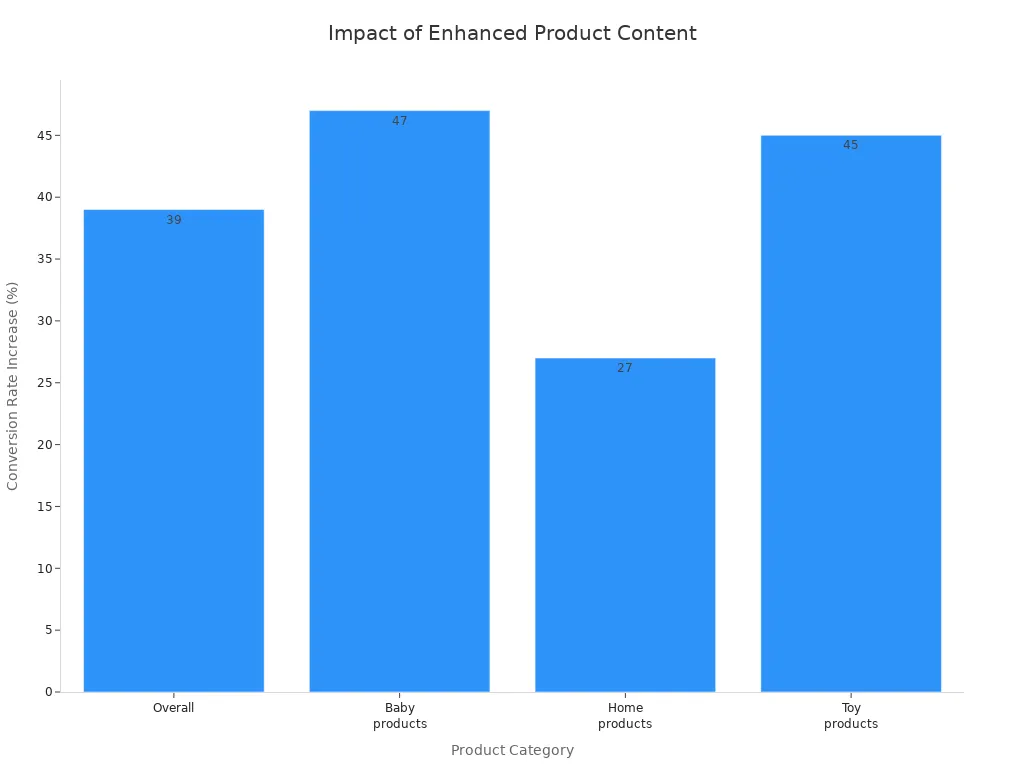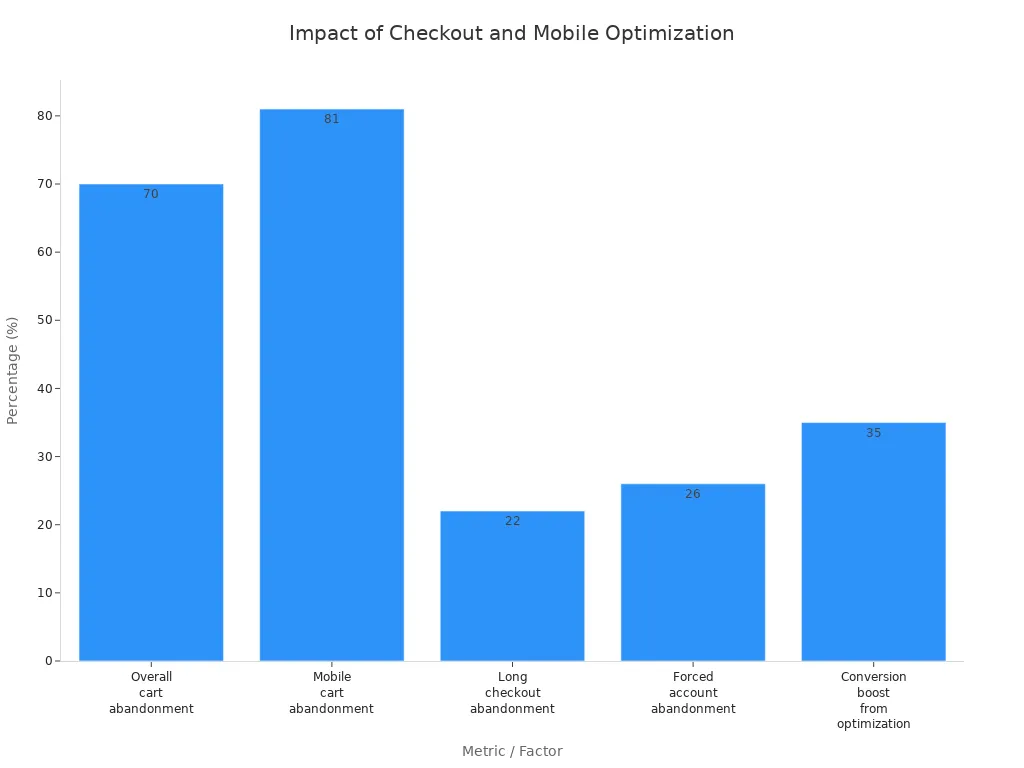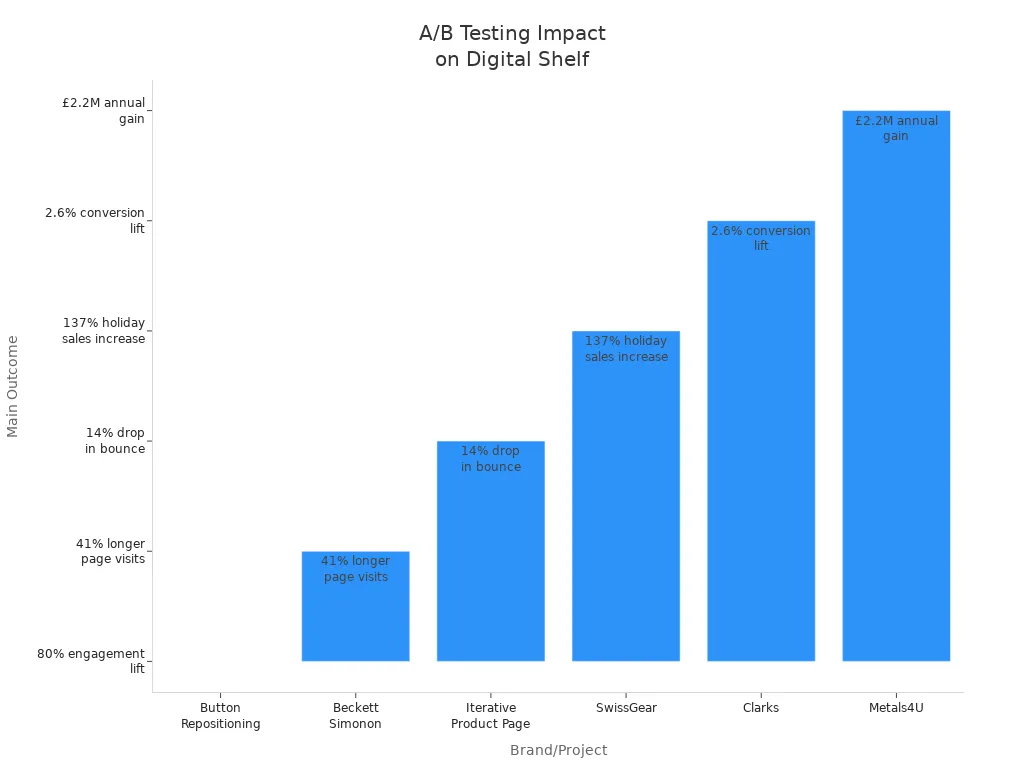
You compete in a market where the digital shelf defines brand success. Today’s ecommerce landscape demands that you win digital shelf battles by maximizing product visibility and delivering a seamless user experience. Over 70% of shoppers never move past the first page of search results, making it vital to optimize every product detail and Electronic Shelf Labels. When you leverage ESL Gateway AP and ESL Price Tag solutions, you enhance Esl Retail efficiency and keep your customer engaged. A holistic strategy—combining data, technology, and customer engagement—ensures you win the digital shelf and drive lasting growth. Winning the digital shelf means adapting to evolving customer behaviors and exceeding expectations at every touchpoint.
What It Means to Win the Digital Shelf
Defining the Digital Shelf
The digital shelf represents the online environment where your products compete for attention. You encounter this shelf every time your product appears on an ecommerce marketplace, a search engine results page, your own website, or even a social media feed. Industry experts describe the digital shelf as the sum of all digital touchpoints—product descriptions, images, reviews, pricing, and availability—that influence consumers’ purchase decisions. Unlike a physical shelf, the digital shelf is dynamic and constantly evolving. You must optimize every element to ensure your products stand out and drive ecommerce revenue.
Key Elements of the Digital Shelf
You need to focus on several core components to win the digital shelf:
- Product availability: Out-of-stock rates directly affect your visibility and sales.
- Imagery: High-quality hero images and multimedia content attract consumers.
- Pricing and promotions: Competitive pricing and timely offers boost conversion.
- Product detail page (PDP) content: Accurate descriptions, ratings, and reviews build trust.
- Search ranking and keyword optimization: These determine how easily consumers find your products.
Each component works together to create a seamless experience. Your digital shelf strategy should address all these areas to maximize impact across ecommerce platforms.
Digital Shelf vs. Physical Retail
| Stage | Physical Shelf Characteristics | Digital Shelf Characteristics |
|---|---|---|
| Awareness | Product placement depends on eye-level spots and store clerks’ help | SEO, PPC, and product page optimization drive ranking; auto-recommendations guide consumers |
| Consideration | Consumers inspect products by touch, try-ons, and social input; may research online | Zoom, 360-degree images, AR try-ons, and detailed reviews compensate for lack of touch; stock availability key |
| Decision | Pricing, coupons, and loyalty cards influence purchase; price checks often happen in-store | Omnichannel deals, real-time price matching, and strategic positioning shape the final decision |
You see that the digital shelf offers more flexibility and reach than physical retail. Consumers rely on detailed content, reviews, and seamless navigation rather than just physical placement.
Why Winning the Digital Shelf Matters
Impact on Brand Visibility and Sales
Winning the digital shelf directly boosts your brand’s visibility and sales. When you optimize key performance indicators like product availability, share of search, content quality, and ratings, you increase impressions, page views, and conversion rates. For example, a consumer packaged goods brand improved its digital shelf strategies on Amazon and saw an 8.5% year-over-year sales increase. Enhanced digital shelf performance also leads to greater market share by making your products easier to discover and buy.
Influence on Consumer Behavior
The importance of the digital shelf extends to every stage of the buyer journey. Consumers discover your products through search rankings and recommendations. They consider your offerings based on images, reviews, and detailed descriptions. When you win the digital shelf, you guide consumers smoothly from discovery to purchase, shaping their decisions and building loyalty. The importance of the digital shelf lies in its power to influence not just what consumers buy, but how they shop and engage with your brand.
Optimized Product Listings: The Foundation to Win Digital Shelf

Optimized product listings serve as the backbone of your digital shelf strategy. You must focus on every detail to ensure your products stand out and drive conversions. When you optimize content, you increase visibility, build trust, and improve sales performance across all channels.
Creating Compelling Product Content
Effective Titles, Descriptions, and Images
You need to craft product titles that are clear, descriptive, and keyword-rich. Titles should match what shoppers search for and highlight the most important features. Descriptions must provide essential information, answer common questions, and use natural language that appeals to your target audience. High-quality images reduce uncertainty and help customers visualize the product. Professional visuals foster trust and credibility, guiding visitors toward conversion actions.
Tip: Use multiple images from different angles and include zoom features to enhance user experience.
- Clear titles improve search ranking and discoverability.
- Detailed descriptions build confidence and reduce returns.
- Strategic image placement increases engagement and conversion rates.
Nike’s visually captivating homepage and Aisle’s lively email campaigns show how compelling visuals and calls to action boost conversions. High-quality product images can lift conversion rates by up to 39% overall, with baby products seeing a 47% increase, home products a 27% rise, and toy products a 45% boost.
| Product Category | Conversion Rate Increase |
|---|---|
| Overall | 39% increase |
| Baby products | 47% lift |
| Home products | 27% increase |
| Toy products | 45% boost |

Video and Enhanced Content
You can further engage shoppers by adding videos, 360-degree spins, and comparison charts to your product detail pages. Videos demonstrate product use and highlight features, making it easier for customers to understand benefits. Enhanced content, such as interactive guides and rich media, increases time spent on product pages and drives higher conversion rates.
- Videos and 360-degree views improve user understanding.
- Comparison charts help shoppers make informed decisions.
- Enhanced content builds trust and encourages purchases.
Detailed specifications and trust badges also reassure shoppers about safety and quality, supporting stronger engagement.
SEO Strategies for Product Listings
Keyword Optimization and Search Ranking
You must target buyer intent and use long-tail keywords to capture specific search queries. Search engines reward relevant, natural keyword usage in titles and descriptions, which improves your product’s search ranking. Avoid duplicate content by using canonical tags and redirects to consolidate page authority.
- Conduct keyword research to identify high-converting terms.
- Use keywords naturally in titles, bullet points, and descriptions.
- Optimize images with descriptive alt text.
- Encourage customer reviews to build trust and improve rankings.
Customer reviews influence purchase decisions, with about 66% of consumers considering reviews important. Positive reviews enhance search rankings and increase conversion rates.
Structured Data and Rich Snippets
You can implement ecommerce schema markups to enable rich snippets in search results. Rich snippets showcase pricing, availability, ratings, and reviews, which boost click-through rates. Structured data helps search engines understand your product detail pages and display them more prominently.
- Add schema markup for products, reviews, and offers.
- Ensure mobile optimization and fast site speed.
- Create keyword-rich URLs for better rankings.
Internal linking and backlinks from relevant blog content also drive referral traffic and improve SEO.
Ensuring Accuracy and Consistency
Managing Product Data and Attributes
Accurate and consistent product data builds consumer trust and enhances the shopping experience. You should centralize product information using Product Information Management (PIM) systems. These platforms ensure real-time accuracy for descriptions, specifications, pricing, and availability across all marketplaces.
- Centralized data management prevents errors and discrepancies.
- Consistent product attributes support better search rankings.
- Digital Asset Management (DAM) platforms maintain high-quality images and videos.
Digital shelf analytics tools help you monitor performance metrics and consumer interactions, enabling continuous optimization of product listings.
Preventing Listing Errors
You must audit product detail pages regularly to prevent errors that can harm brand reputation and search rankings. Digital shelf analytics platforms empower you to correct inaccuracies daily. Accurate and compliant product data supports strong retailer relationships and mutual revenue growth.
Note: Discrepancies in product information across platforms can erode trust and reduce sales.
Generative AI and analytics tools allow you to respond quickly to market changes and shopper habits, improving digital shelf performance. Consistency in product information is essential because consumers search by brand, product characteristics, and item names.
Enhancing User Experience to Win the Digital Shelf
Streamlined Navigation and Search
Intuitive Categories and Filters
You create a winning digital shelf by making navigation effortless. When you organize products into clear categories and provide accurate filters, you help consumers find what they want quickly. Research shows that 94% of users value fast and easy navigation as the most useful website feature. Auto-complete and auto-suggest functions speed up the search process, while consistent product tags enable precise filtering. When you reduce friction in navigation, you minimize frustration and keep shoppers engaged.
Advanced Search Capabilities
Advanced search tools transform the user experience. AI-powered search interprets natural language queries and delivers relevant results, even when consumers use vague or visual searches. Personalized navigation tailors category pages to individual preferences, improving browsing and boosting conversions. The following table highlights the impact of streamlined navigation and search:
| Evidence Type | Details |
|---|---|
| Statistic | 26% increase in conversions for customers using search after implementing Searchspring. |
| Statistic | 85% of shoppers say visual information is more important than text for clothes and furniture. |
| Best Practice | Personalized search experiences increase purchase likelihood by 80%. |
| Statistic | 28% of online shoppers cite irrelevant search results as their biggest frustration. |
You retain more shoppers and drive higher conversion rates when you invest in intuitive navigation and advanced search.
Frictionless Checkout and Mobile Optimization
Simplified Checkout Process
A seamless checkout process is essential for a positive user experience. You can reduce cart abandonment by minimizing form fields, offering guest checkout, and saving customer details for future purchases. Data shows that 22% of shoppers abandon carts due to long or complicated checkouts, while 26% leave when forced to create an account. Streamlining these steps leads to a significant conversion boost—up to 35%.
Mobile-First Design and Fast Load Times
Mobile commerce now accounts for 38% of all digital spending in the US. Over 50% of ecommerce traffic comes from mobile devices, but mobile users abandon carts at rates as high as 85% when the experience falls short. You must prioritize mobile optimization with responsive design, fast load times, and easy navigation. Usability studies confirm that slow page load times increase bounce rates and reduce conversions, especially within the first five seconds. Optimizing images, reducing unnecessary scripts, and enabling browser caching all improve the consumer experience.

Tip: Regularly test your checkout flow on multiple devices to identify and remove friction points.
Personalization Across the Customer Journey
Dynamic Recommendations
Personalization drives repeat purchases and increases customer satisfaction. When you use dynamic recommendations based on browsing and purchase history, you deliver relevant products that match each customer’s needs. Studies show that personalized calls-to-action outperform generic ones by 202%, and 60% of shoppers expect to become repeat buyers after a personalized experience.
Tailored Promotions
You can further enhance the user experience by offering tailored promotions. Over 70% of consumers consider personalization a basic expectation, and 61% are willing to spend more with brands that customize their service. Companies that lead in personalization report higher retention, loyalty, and revenue growth. By integrating dynamic offers and personalized messaging throughout the journey, you create a consumer experience that keeps customers coming back.
Tips to Win the Digital Shelf with Personalized Marketing

Personalized marketing stands as a powerful strategy in your quest for tips to win the digital shelf. You can leverage data-driven insights to deliver relevant experiences, boost engagement, and drive repeat purchases. When you understand your target audience, you create tailored campaigns that resonate and convert.
Leveraging Data for Personalization
Customer Segmentation and Targeting
You must segment your customer base to deliver precise messaging. Digital Shelf Analytics help you identify distinct groups based on demographics, purchase history, and browsing behavior. AI-driven product recommendations use this data to enhance customer engagement and foster repeat purchases. You can launch hyper-targeted campaigns that speak directly to each segment, increasing relevance and conversion rates.
- AI-driven recommendations boost repeat purchases.
- Segmentation enables hyper-targeted marketing.
- Real-time data supports agile campaign adjustments.
Behavioral Insights and Triggers
You gain a competitive edge by tracking behavioral triggers such as abandoned carts, frequent searches, or repeat visits. Automation and algorithms suggest products based on user preferences, driving personalized marketing efforts. Amazon’s dynamic homepage uses past actions to recommend products, increasing conversions and strengthening customer relationships. Personalization can lead to a 30% increase in ROI and a 50% reduction in acquisition costs.
Dynamic Content and Retargeting
Personalized Product Suggestions
You can use dynamic content to present personalized product recommendations at every touchpoint. Automation tailors suggestions to each customer’s browsing and purchase history, making your digital shelf more relevant. Waterstones, for example, suggests books aligned with user interests, demonstrating how industry leaders apply these tips to win the digital shelf.
Abandoned Cart Recovery and Email Campaigns
Retargeting strategies re-engage visitors who leave without converting. Display retargeting ads show products browsed, while email campaigns remind users of items left behind. Peer Software increased conversion rates by 128% through intelligent retargeting ads. Brands like Nike and Nordstrom use dynamic ads and email retargeting to boost engagement and drive sales. Timing and personalization in retargeting campaigns maximize ROI and nurture leads.
Tip: Segment audiences by recency and tailor messaging to user behavior for higher conversion rates.
Building Loyalty Through Engagement
Loyalty Programs and Exclusive Offers
You build lasting relationships by offering loyalty programs, exclusive discounts, and memberships. Research shows that shopper loyalty, driven by coupons and subscriptions, is vital for maintaining a competitive advantage and encouraging repeat purchases. These programs enhance customer retention and lifetime value, shifting your focus from one-time conversions to deeper connections.
Post-Purchase Communication
You must maintain communication after the sale to reinforce loyalty. Positive experiences during delivery, transparent updates, and convenient returns drive satisfaction and repeat purchases. Even small improvements in customer satisfaction can lead to incremental revenue growth. Branded tracking and post-purchase engagement keep your brand top-of-mind and encourage future transactions.
Note: Consistent post-purchase communication strengthens customer loyalty and supports long-term digital shelf success.
Integrating Cross-Channel Efforts for Winning the Digital Shelf
Omnichannel Strategy and Consistent Messaging
Unified Brand Experience
You need to create a unified brand experience across every channel. When you align your messaging, visuals, and promotions on ecommerce sites, social media, and physical stores, you help customers recognize your brand instantly. A unified digital shelf strategy enhances product discovery and personalization. Customers expect the same quality and information whether they shop online or in-store. This consistency builds trust and encourages repeat purchases. By integrating your merchandising efforts, you deliver a seamless journey that increases conversion rates and customer retention.
Seamless Online and Offline Integration
You can boost your digital shelf performance by connecting online and offline experiences. Real-time inventory visibility and options like Buy Online, Pick Up In Store (BOPIS) influence purchase decisions. When you use an omni-channel approach, you adapt to channel-specific behaviors while maintaining brand consistency. Companies like Home Depot have improved operational efficiency and created cohesive shopping experiences by unifying data and processes. This integration reduces friction, supports smarter staffing, and helps you optimize resources for better service.
Social Commerce and Marketplace Optimization
Shoppable Social Posts
Social commerce continues to transform how you reach customers. Shoppable posts on platforms like Instagram and TikTok allow users to buy products directly from their feeds. This approach connects you with consumers in real time and provides valuable feedback. US retail social commerce sales are projected to exceed $100 billion by 2025, showing rapid growth. Social commerce also helps you gather market intelligence and respond quickly to trends, making your brand more responsive and visible.
Third-Party Retailer Collaboration
You can expand your reach by optimizing your presence on third-party marketplaces. Integrating with retail media and using unified campaign management tools lets you manage campaigns across multiple retailers and social platforms. This strategy amplifies your marketing effectiveness and drives full-funnel performance improvements. Marketplace integration ensures your merchandising adapts to each channel while keeping your brand message consistent. As spending per buyer rises, marketplace optimization becomes essential for sustained growth in ecommerce.
Influencer Partnerships and Community Building
Leveraging Influencers for Reach
Influencer partnerships give you access to new consumer segments. When you work with influencers who align with your brand values, you reach large and engaged audiences. Influencers drive product discovery and social selling by sharing authentic stories and trusted recommendations. Long-term partnerships foster deeper engagement and cultural resonance, moving audiences further down the purchase funnel. You benefit from increased reach, while influencers gain exposure and compensation.
Encouraging User-Generated Content
You can build a strong community by encouraging user-generated content. Audiences trust influencers who share personal experiences over polished endorsements. Platforms like TikTok and Reddit act as search engines where firsthand stories serve as trust signals. By supporting creators who connect authentically with your brand, you foster loyalty and ongoing engagement. This approach helps you grow your digital shelf presence and build lasting relationships with your customers.
Tip: Focus on authentic narratives and long-term partnerships to strengthen your brand community and drive digital shelf growth.
Ensuring Supply Chain Efficiency to Win Digital Shelf
Supply chain efficiency forms the backbone of your digital shelf success. When you streamline inventory, fulfillment, and logistics, you ensure products remain visible, available, and ready for purchase. Digital supply chain solutions give you real-time visibility and predictive analytics, which help you align supply with demand and keep your digital shelf fully stocked. This approach not only improves customer satisfaction but also strengthens your brand’s reputation and drives business growth.
Real-Time Inventory Management
Stock Updates and Availability
You need real-time inventory management to keep your digital shelf competitive. Automated systems and cloud-based platforms let you monitor stock levels across all locations from a single dashboard. When inventory drops below a set threshold, automated reordering triggers purchase orders, ensuring timely replenishment. IoT sensors and RFID technology provide instant updates, reducing manual errors and keeping your inventory data accurate. These tools help you maintain product availability and avoid lost sales.
- Automated reordering systems prevent stockouts by triggering orders as soon as inventory runs low.
- Real-time notifications allow you to act quickly, reducing delays and simplifying logistics.
- RFID and barcode scanning speed up stock checks and keep your data current.
Preventing Out-of-Stocks
Out-of-stock events directly impact your sales and customer satisfaction. Predictive analytics powered by AI forecast demand trends and recommend restocking strategies. You can optimize safety stock levels to balance between too little and too much inventory. Industry leaders like Toyota use real-time supplier monitoring to identify bottlenecks early and maintain just-in-time inventory. These practices help you avoid empty shelves and keep your digital shelf resilient.
Note: Academic research shows that On-Shelf Availability (OSA) is critical for customer satisfaction. OSA ensures products are always available, which is central to a positive shopping experience and business profitability.
Fast Fulfillment and Returns
Shipping Options and Delivery Tracking
Fast fulfillment sets your brand apart on the digital shelf. You should offer multiple shipping options and provide real-time delivery tracking. Ecommerce data platforms track fulfillment speed, shipping costs, and carrier reliability, giving you insights into product flow and customer experience. Optimized inventory placement and efficient logistics reduce delivery times and improve conversion rates.
- Amazon Retail Analytics lets you monitor shipped orders, tracking, and returns at the product level.
- Predictive analytics help you anticipate bottlenecks and optimize inventory for faster delivery.
Simple Return and Exchange Processes
Easy returns build trust and encourage repeat purchases. You need to streamline return and exchange processes, making them simple for customers. Retail analytics track return patterns by SKU and location, helping you identify issues and improve your processes. Fast fulfillment and easy returns reduce cart abandonment and increase your chances of winning the Buy Box.
Tip: A hassle-free return policy can boost customer loyalty and set your brand apart in a crowded marketplace.
Adapting to Demand Fluctuations
Forecasting and Flexibility
Demand can shift quickly, so you must stay agile. AI and machine learning predict demand fluctuations and optimize inventory in real time. You can use automation to adjust stock levels and respond to sudden changes. Companies like Dyson and Toyota have shown how flexible supply chains recover from disruptions and adapt to new market needs.
- 41% of supply chain leaders identify demand variability as a top challenge.
- Flexible outsourcing and crowdsourced delivery fleets help you maintain service during demand surges.
Resource Allocation
Smart resource allocation keeps your supply chain resilient. The R4 resilience framework—Robustness, Redundancy, Resourcefulness, Rapidity—supports last-mile distribution during disruptions. You can use multiple logistics providers and collection-point pickups to handle fluctuating demand. Integrating AI, digital twins, and cyber-physical systems enables you to monitor and optimize logistics dynamically, ensuring your digital shelf stays stocked and responsive.
By embracing digital supply chain solutions, you position your brand to meet customer expectations, reduce lost sales, and win on the digital shelf every day.
Continuously Optimizing and Winning the Digital Shelf with Data
Monitoring Key Performance Metrics
Conversion Rates and Traffic Sources
You must monitor key metrics to maintain your edge in winning the digital shelf. Track conversion rates and traffic sources to understand which channels drive the most engaged shoppers. Digital shelf analytics platforms provide real-time insights into visitor behavior, helping you identify high-performing campaigns and underperforming segments. When you analyze traffic sources, you can allocate resources to channels that deliver the best results. This approach supports continuous optimization and ensures your marketing spend drives measurable growth.
Product Page Performance
Evaluate product page performance using digital shelf analytics. Measure bounce rates, time on page, and interaction with content elements. You can identify friction points and optimize layouts for better engagement. For example, brands that repositioned call-to-action buttons above product descriptions saw an 80% lift in engagement and 23% fewer returns. Use these insights to refine your product pages and boost conversion.
A/B Testing and Experimentation
Content and Promotion Testing
A/B testing empowers you to make data-driven decisions. Test different headlines, images, and promotional offers to discover what resonates with your audience. Brands like Every.org increased conversions by 26.5% after simplifying their donation form. Bannersnack used heatmaps to adjust CTA buttons, resulting in a 25% rise in sign-ups. Turum-burum’s work for Intertop, which included reducing checkout form fields and adding autofill, led to a 54.68% increase in conversion rate and an 11.46% growth in average revenue per user.
- Use session replays, heatmaps, and surveys to gather behavioral insights.
- Identify friction points with exit-intent pop-ups.
- Combine qualitative and quantitative data for holistic optimization.
Iterative Improvements
Continuous experimentation drives long-term success. Brands that adopted iterative product page tests, such as collapsible specs sections, achieved a 14% drop in bounce rates during peak traffic. SwissGear pre-tested changes before the holiday season and saw a 137% increase in sales. Clarks lifted conversions by 2.6%, generating £2.8 million in additional revenue. Metals4U’s post-test monitoring led to a £2.2 million annual gain and a 19% higher lifetime value.
| Brand/Project | Tested Element/Strategy | Outcome/Impact |
|---|---|---|
| Button Repositioning | Moving button above product descriptions | 80% lift in engagement; 23% fewer returns |
| Beckett Simonon | Sustainability stories, videos, sticky charts | 41% longer visits; 19% fewer support queries; 5% more purchases |
| SwissGear | Pre-testing before holiday season | 137% increase in holiday sales |
| Metals4U | Friction removal monitoring | £2.2M annual gain; 19% higher lifetime value |

Adapting to Market Trends and Challenges
Competitive Analysis
You must stay vigilant as market trends shift. Digital shelf analytics tools reveal competitors’ pricing, promotions, and keyword strategies. Benchmark your performance and adjust your approach to maintain your position. Monitor search visibility, product availability, and content performance to respond proactively to changes.
- Use ai-driven digital shelf analytics for deeper insights.
- Optimize retail media campaigns to improve ROI and strengthen your marketplace position.
Responding to Platform Changes
Agility is essential for winning the digital shelf. Ecommerce platforms update requirements frequently—Amazon changed its rules 217 times in 2024, Walmart 241 times, and other retailers over 100 times. You need to monitor these changes and adjust your strategies quickly. Constant shifts in search engine algorithms demand rapid adaptation to maintain product visibility. The rise of private-label brands and digital-first startups increases competition, making it vital to optimize content and pricing. Automation and advanced analytics reduce manual effort, allowing you to focus on innovation and future-proof your digital shelf presence.
Tip: Adopt dynamic pricing strategies and automation tools to efficiently manage complexities and stay ahead of market disruptions.
Overcoming Challenges to Win the Digital Shelf
Navigating Platform and Algorithm Changes
Staying Compliant and Agile
You face constant changes in ecommerce platform algorithms and requirements. To stay compliant and agile, you must set clear goals for your digital shelf strategy and prioritize resources for the most impactful brands and products. Assign roles to content writers, analysts, and supply chain experts to execute your plan efficiently. Regularly track key performance indicators (KPIs) to identify both wins and areas needing improvement. Use a robust toolkit for measurement, content management, review syndication, paid media, and distributed commerce. Secure executive support to sustain your efforts as platforms evolve.
| Strategy Component | Description |
|---|---|
| Planning | Set clear organizational goals tailored to digital shelf success. |
| Prioritization | Focus resources on key brands, retailers, and products to maximize impact. |
| Personnel | Assign roles such as content writers, analysts, and supply chain experts. |
| Monitoring | Develop KPIs and regularly track progress. |
| Toolkit | Use tools for measurement, content management, and review syndication. |
| Optimization | Continuously update strategy based on insights and competitor benchmarking. |
| Commitment | Secure executive support and funding. |
Managing Multiple Retailer Requirements
Each retailer has unique requirements for product listings, content, and compliance. You must use digital shelf analytics tools to track search rank, content compliance, pricing, and stock levels in real time. Optimize your product listings with algorithm-friendly titles, images, and descriptions tailored to each retailer. Encourage customer feedback and reviews to build trust and improve visibility. Continuously monitor, test, and optimize product elements through A/B testing. Leverage AI and predictive analytics to anticipate and respond to changes proactively.
Breaking Down Data Silos
Integrating Systems and Data Sources
You often encounter fragmented data across platforms, which can hinder your digital shelf performance. Integrate your systems and data sources to create a unified view of your business. Use centralized platforms to connect inventory, sales, and marketing data. This integration enables you to make informed decisions quickly and respond to market shifts with agility.
Improving Data Accessibility
Improved data accessibility empowers your teams to act on insights faster. Provide access to real-time dashboards and analytics so everyone from marketing to supply chain can collaborate effectively. When you break down data silos, you enable seamless communication and faster execution of digital shelf strategies.
Competing with Established and Niche Brands
Differentiation Strategies
You compete with both established giants and agile niche brands. Focus on what sets your brand apart. Brands like Oishii use high-end visuals and user-generated content to create an exclusive yet relatable experience. Ritual blends education and conversion with ingredient sourcing details and video testimonials. McCormick turns spice shopping into a story-rich journey with recipe content and curated bundles. Ghia combines poetic copy and lifestyle imagery with clear calls to action, inviting exploration while driving purchases. Successful brands iterate by mining customer feedback from reviews and social media to optimize visuals and content.
Focusing on Unique Value Propositions
Highlight your unique value proposition to stand out. Niche brands often curate focused product portfolios, like Taco Libre’s limited taco menu or BowlDaddy’s low-carb cauliflower rice line, which increased sales by 45%. Use competitor analysis to track rivals’ delivery times and identify opportunities. Optimize your visual content and menu offerings, as TacoTerror did with thumbnail A/B testing that improved conversions by 55%. Large companies sometimes acquire niche brands to access specific audiences, as seen with Unilever and Dollar Shave Club. Always understand your digital shelf competitors and shop your own brand online to gain valuable insights.
Tip: Integrate creative storytelling, customer feedback, and continuous optimization to differentiate your brand and win on the digital shelf.
You drive success when you focus on winning the digital shelf. Continuous innovation and data-driven decisions help you win digital shelf battles and create an acceleration of growth for your brand.
Audit your digital shelf, optimize every detail, and commit to improvement daily.
- Take action now
- Stay agile
- Win digital shelf every day
FAQ
What is the digital shelf?
You encounter the digital shelf whenever your products appear online. It includes product pages, search results, social media, and marketplaces. You must optimize every touchpoint to increase visibility and drive sales.
How do you optimize product listings for the digital shelf?
You improve product listings by using clear titles, detailed descriptions, and high-quality images. You add relevant keywords and structured data. You update information regularly to maintain accuracy.
Why does mobile optimization matter for digital shelf success?
Mobile shoppers expect fast, easy navigation. You lose sales if your site loads slowly or checkout is complicated. Responsive design and quick load times help you keep mobile users engaged.
What tools help you monitor digital shelf performance?
You use digital shelf analytics platforms to track conversion rates, search rankings, and inventory. These tools provide real-time insights, helping you identify opportunities and address issues quickly.
How can you prevent out-of-stock situations?
You implement automated inventory management systems. These tools alert you when stock runs low and trigger reordering. You maintain product availability and avoid lost sales.
What is the role of personalization in winning the digital shelf?
You deliver tailored recommendations and promotions based on customer behavior. Personalization increases engagement and encourages repeat purchases. You build loyalty by meeting individual needs.
How do you stay compliant with changing retailer requirements?
You monitor retailer guidelines and update product content as needed. You use analytics tools to track compliance. You assign roles to ensure your team responds quickly to changes.
Can you win the digital shelf against larger competitors?
You focus on your unique value proposition. You use creative storytelling, optimize content, and engage your community. You analyze competitors and adapt your strategy to stand out.


